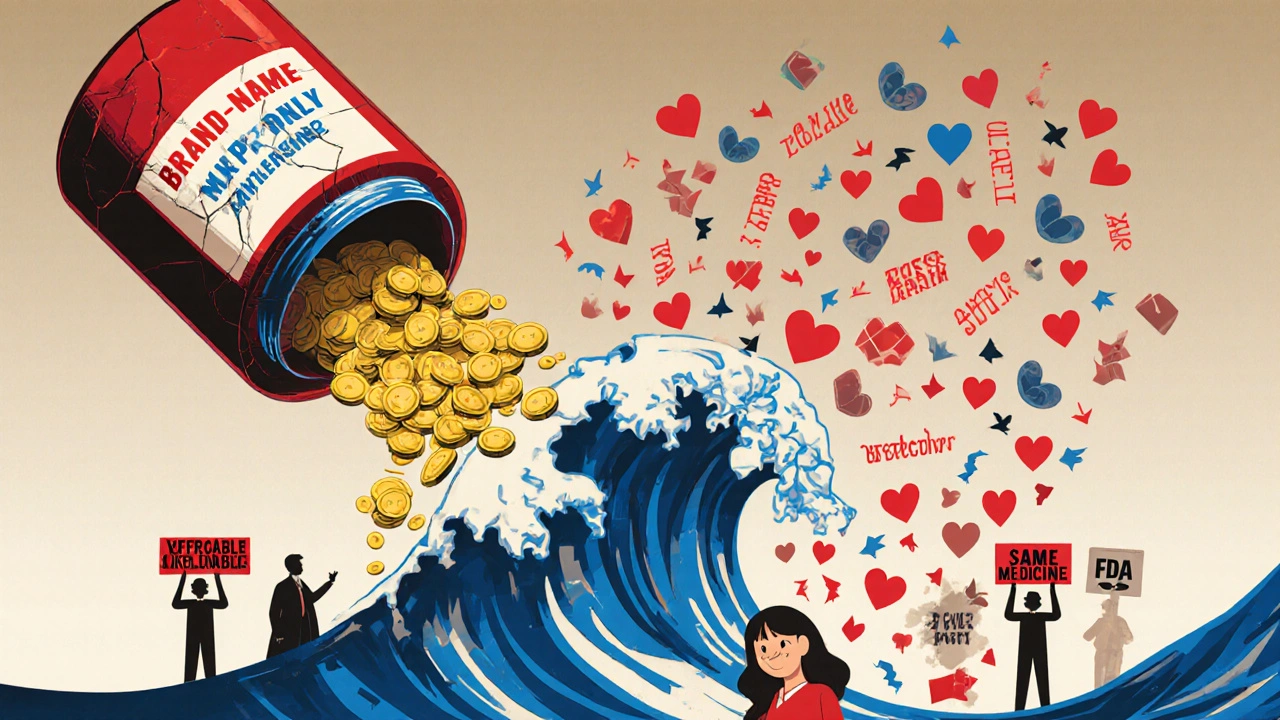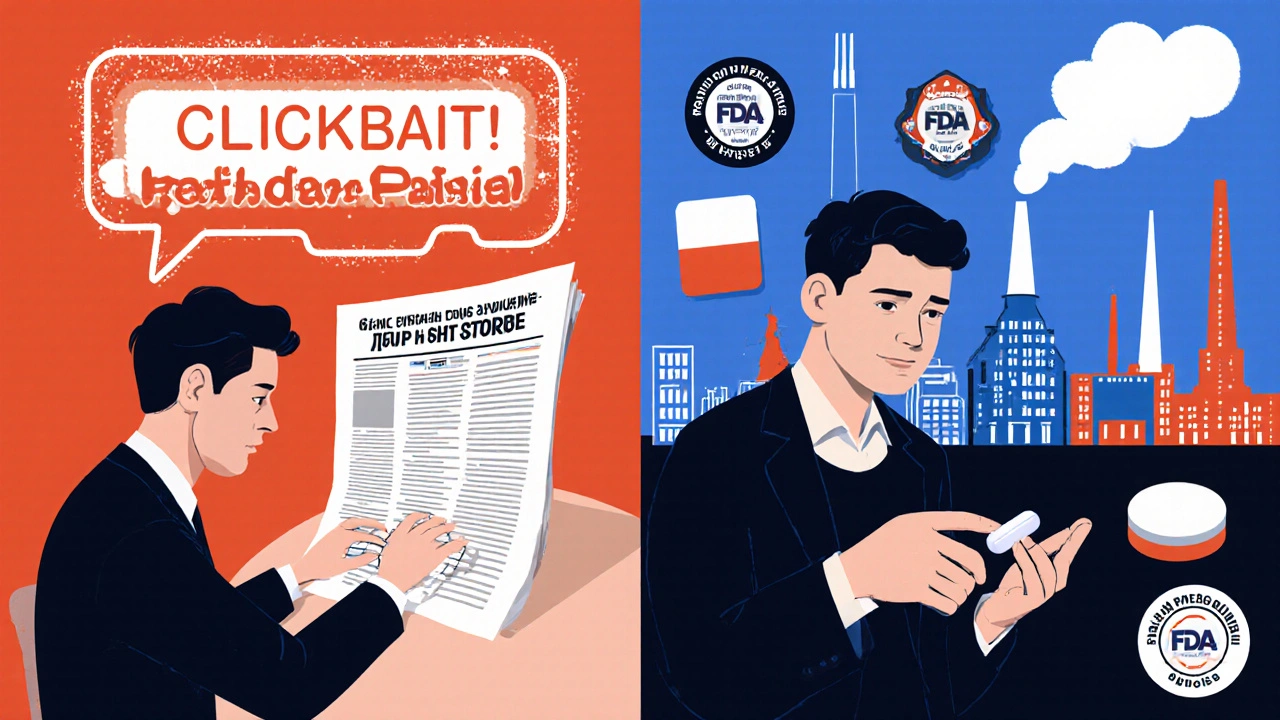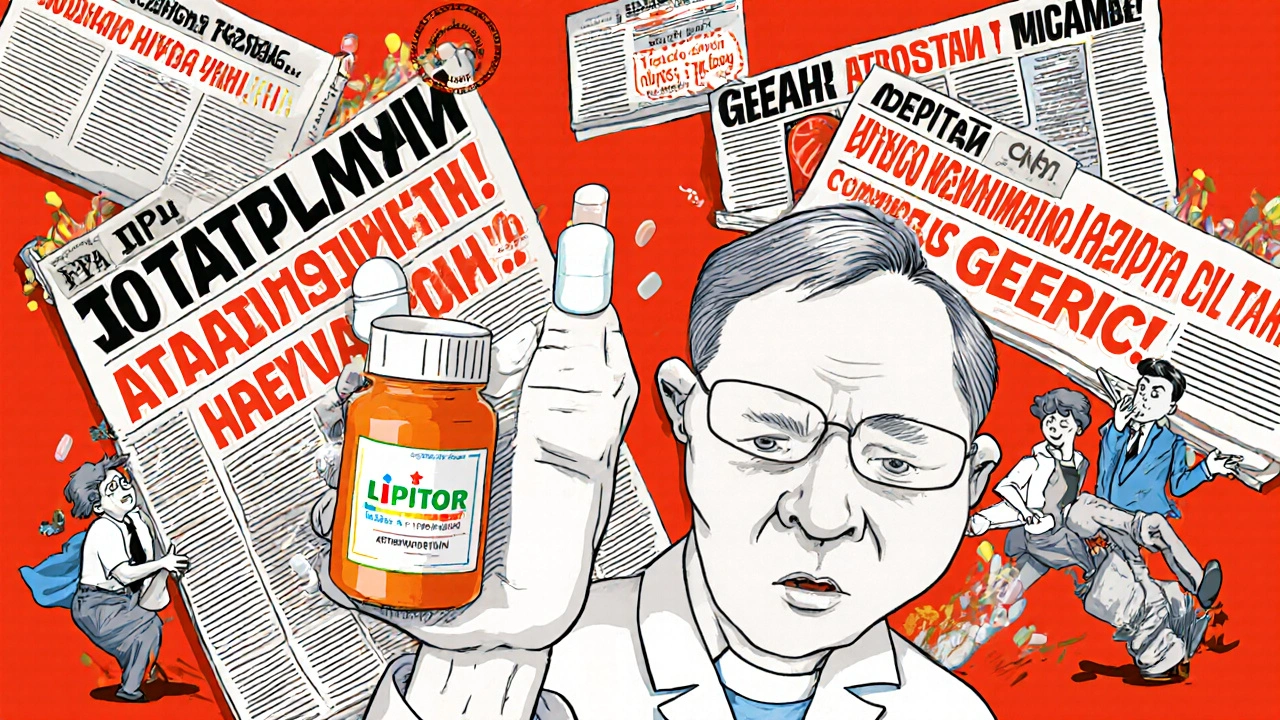When you pick up a prescription, you might not realize the pill in your hand could be a generic version of a brand-name drug. But if you’ve ever hesitated to take it-wondering if it’s really the same-you’re not alone. Generic drugs make up 84% of all prescriptions filled in the U.S., yet nearly half of patients can’t tell the difference between a generic and a brand-name pill. And the reason? It’s not science. It’s the news.
What the Media Gets Wrong About Generic Drugs
News headlines like “Contaminated Generic Drugs Reveal an Urgent Public Health Crisis” or “How Some Generic Drugs Could Do More Harm Than Good” sound alarming. They grab attention. But they rarely tell the full story. These stories often focus on rare cases of contamination or manufacturing issues, painting all generics with the same brush. The truth? The FDA holds every generic drug to the same strict standards as brand-name drugs. They must contain the same active ingredient, in the same strength, and work the same way in the body. Minor differences in fillers or shape don’t change how the drug works. Yet media reports rarely mention this. Instead, they use brand names like “Lipitor” or “Zoloft” when describing medications-even when the article is about the generic versions. A 2014 study in JAMA Network found that only 2% of newspapers had policies requiring reporters to use generic names. That means readers hear “Lipitor” and assume the cheaper version is somehow different. It’s not. It’s the same medicine, just without the marketing.Why Patients Trust the News More Than Their Doctor
You’d think your doctor or pharmacist would be the most trusted source when it comes to medication. And they are-when they speak up. But too often, they don’t. A 2023 study from the University of Texas at Dallas showed that after patients received bad health news-like a cancer diagnosis or high cholesterol-they were far more likely to insist on brand-name drugs, even if it meant paying three times more. Why? Because fear makes people seek control. And when the news tells them generic drugs are risky, they believe it. Even worse, many patients simply don’t know what a generic drug looks like. Only 17% of people in one 2023 study could correctly identify a generic medication package. Forty percent couldn’t tell the difference between brand and generic labels. That’s not ignorance. It’s confusion created by inconsistent labeling, lack of public education, and media narratives that imply generics are second-rate.
The Real Cost of Mistrust
This isn’t just about perception. It’s about money-and health. People who avoid generics because of fear often skip doses or stop taking their meds altogether because they can’t afford the brand version. Studies show patients on generics are actually more likely to stick to their treatment plan. Why? Because they can afford it. One study in US Pharmacist found that people taking generics were significantly less likely to skip doses than those on brand-name drugs. Meanwhile, drug prices drop by about 20% when there are three or more generic competitors on the market. That’s not a rumor. It’s data from the HHS ASPE report in 2023. But you won’t hear that in the news. You’ll hear about a single generic that spiked in price-usually because of a shortage or a small manufacturer’s bad decision. That one case becomes the story. The broader trend-lower prices, better access-is ignored.Who’s Responsible for Fixing This?
The FDA says all approved generics must prove they’re therapeutically equivalent to the brand. That’s not just a slogan. It’s backed by years of testing. But the agency can’t fix media bias alone. Pharmacists are on the front lines. They’re the ones handing out the pills, answering questions, and seeing patients’ hesitation firsthand. Yet many pharmacists say they don’t have enough time to explain the difference. Doctors, too, often don’t bring it up. If a physician says, “This generic is just as good,” but the patient just read a headline saying otherwise, the doctor’s words get drowned out. The real solution? Consistent, clear communication-from doctors, pharmacists, and the media. A 2015 review in PMC found that the most effective way to build trust in generics is education. Not ads. Not slogans. Real conversations. Explaining that the FDA tests every batch. That the same factories sometimes make both brand and generic versions. That the only real difference is the price tag.
What You Can Do Right Now
If you’re on a generic medication and you’re unsure, ask your pharmacist. Not just “Is this the right pill?” but “How is this the same as the brand?” Most will happily explain. They see this every day. If you’re reading a news story about a generic drug recall or safety issue, check the source. Is it a major outlet with a medical editor? Did they mention the FDA’s role? Did they clarify whether this was a rare case or a widespread problem? If not, be skeptical-not of the drug, but of the story. And if you’re a patient who’s been told to switch to a generic, don’t assume it’s a cost-cutting move by your insurer. It’s a science-backed choice. The FDA doesn’t approve generics based on price. They approve them based on performance.Why This Matters Beyond Your Prescription
This isn’t just about pills. It’s about how we process information in a world full of fear-driven headlines. When the media conflates rare failures with systemic risk, it erodes trust in public health systems. It makes people afraid of affordable care. And it keeps people from getting the treatment they need because they think cheaper means worse. The truth is simple: generics save lives. They save billions in healthcare costs. They make chronic disease management possible for millions who couldn’t otherwise afford it. But none of that matters if people don’t believe it. The fix won’t come from a government mandate or a new law. It’ll come from better conversations. From pharmacists taking five extra minutes. From doctors naming the generic drug first. From journalists who stop saying “Lipitor” when they mean “atorvastatin.” And from patients who ask questions instead of assuming the worst. The science is settled. The data is clear. The only thing left to change is the story we’re telling ourselves.Are generic drugs really as effective as brand-name drugs?
Yes. The FDA requires generic drugs to have the same active ingredient, strength, dosage form, and route of administration as the brand-name version. They must also prove they work the same way in the body. Thousands of studies have confirmed this. The only differences are in inactive ingredients like fillers or color-things that don’t affect how the drug works.
Why do some people feel generics don’t work as well?
Some people notice small differences in how the pill looks or feels, or they experience a placebo effect after switching. Others have had bad experiences with a specific generic batch, often due to rare manufacturing issues. But these are isolated cases. The FDA investigates every reported problem, and the vast majority of generics perform identically to brand drugs. The perception of reduced effectiveness is usually tied to media stories or lack of information-not science.
Can I trust generics made in other countries like India or China?
Yes. The FDA inspects all facilities that make drugs sold in the U.S., whether they’re in New Jersey or New Delhi. Over 40% of generic drugs sold in the U.S. are made overseas, and nearly all of them meet U.S. standards. The FDA conducts thousands of inspections each year. If a facility fails, it’s shut down. The issue isn’t where the drug is made-it’s whether the FDA has approved it.
Why do doctors and pharmacists sometimes prefer brand-name drugs?
Some do-but not because they think generics are inferior. Often, it’s because they’re unfamiliar with a new generic version or haven’t had time to learn about it. A 2015 study found that pharmacists who understood the science behind generics were far more likely to recommend them. The problem isn’t expertise-it’s exposure. Education helps.
What should I do if I think my generic drug isn’t working?
Don’t stop taking it. Don’t switch back to the brand without talking to your doctor. Instead, write down what you’re feeling-side effects, changes in symptoms, timing. Then bring it to your pharmacist or doctor. Most of the time, the issue isn’t the drug itself. It could be dosage, timing, diet, or another medication interacting with it. Your provider can help sort it out.
How can I tell if my medication is generic?
Check the label. Generic drugs are listed by their chemical name (like “metformin”) rather than the brand name (like “Glucophage”). The packaging may also say “generic” or list the manufacturer’s name instead of a well-known brand. If you’re unsure, ask your pharmacist-they’ll tell you for free.


Ancel Fortuin
November 19, 2025 AT 12:01Oh wow, another ‘trust the FDA’ pamphlet. Let me guess-next you’ll tell me the moon landing was real and Big Pharma isn’t just outsourcing their profits to some guy in Bangalore who uses a toothbrush to stir the active ingredient? 😏
Hannah Blower
November 21, 2025 AT 00:48Let’s be brutally honest-the media doesn’t ‘misrepresent’ generics, it reflects a deeper societal pathology: the irrational worship of brand as identity. You don’t just buy Lipitor-you buy the *idea* of being someone who can afford to be sick properly. Generics are the pharmaceutical equivalent of store-brand toilet paper. And we all know how that ends.
Gregory Gonzalez
November 21, 2025 AT 01:51Wow. So the solution to media bias is... asking your pharmacist? That’s like saying the solution to climate change is buying a reusable tote bag. The problem isn’t that people don’t know- it’s that they’ve been systematically conditioned to distrust anything that doesn’t come with a logo and a 300% markup.
Ronald Stenger
November 22, 2025 AT 13:26India and China make most of our generics? That’s why our kids are dying from fake pills. We’re outsourcing our healthcare to a country that can’t even keep their streets clean. The FDA inspects? Please. How many of those inspectors speak Hindi? Or Mandarin? Or even understand what ‘active ingredient’ means when it’s mixed with goat dung and glitter?
Samkelo Bodwana
November 23, 2025 AT 04:32I get why people are scared. I used to be one of them. My dad took a generic blood pressure med and thought he was being ‘cheated’-until he sat down with his pharmacist and learned that the same factory that made his $120 brand pill also made the $5 generic. Same machine. Same batch. Same guy in the lab coat. He cried. Not because he was mad-but because he realized he’d been scared of a ghost. The real villain isn’t the generic. It’s the silence. The lack of explanation. The assumption that we’re too dumb to understand. We’re not. We just need someone to talk to us like humans.
Jeff Hakojarvi
November 24, 2025 AT 09:51Yessss! This is so true. I’m a pharmacist and I see this every day. People panic when they get a pill that looks different-even if it’s the exact same drug. I just say, ‘Hey, this is the same as your old one, just cheaper. Want me to show you the FDA equivalence chart?’ 90% of them breathe a sigh of relief. We just need more time to talk. Not ads. Not headlines. Just five minutes.
Timothy Uchechukwu
November 26, 2025 AT 03:09Emily Entwistle
November 27, 2025 AT 19:35OMG YES 🙌 I switched to generic Zoloft last year and my anxiety didn’t get worse-my wallet did 😭 Thank you for saying this. My pharmacist even gave me a sticker that says ‘I’m a generic warrior’ 🩷💊
Duncan Prowel
November 29, 2025 AT 16:11It is, indeed, a fascinating sociological phenomenon: the conflation of cost with quality, and the subsequent erosion of epistemic trust in regulatory institutions. One might posit that this reflects a broader cultural shift toward epistemic nihilism, wherein empirical evidence is superseded by affective narratives propagated by media ecosystems optimized for outrage. The FDA’s standards remain robust; the problem lies in the communicative failure of those entrusted with disseminating them.
Bruce Bain
November 30, 2025 AT 21:50I’m just a regular guy. I don’t know science. But I know this: I used to pay $150 a month for my heart med. Now I pay $12. I feel the same. I’m alive. So I say-stop overthinking it. If it works, it works. Simple.
Jonathan Gabriel
November 30, 2025 AT 22:07Okay but… if the FDA approves them, and the same factories make them, and the active ingredient is identical… then why does the placebo effect still work so hard against generics? Is it the shape? The color? The fact that it doesn’t have a logo? Or is it that we’ve been brainwashed by decades of marketing to believe that ‘more expensive = more powerful’? We’re not stupid. We’re just… conditioned. Like Pavlov’s dogs, but with pill bottles.
Don Angel
December 1, 2025 AT 14:23Look. I get it. People are scared. I’ve been there. I used to refuse generics too. But after my kid needed asthma meds and we couldn’t afford the brand, I tried the generic… and nothing changed. Not a single side effect. Not a single flare-up. So now? I’m the guy who tells everyone: ‘Don’t trust the headline. Trust your body. And ask your pharmacist.’ Seriously. They’re the real heroes.
benedict nwokedi
December 3, 2025 AT 03:37Let’s not pretend this is about ‘media bias.’ This is about the deliberate, systemic dismantling of American healthcare by globalist conglomerates who want you dependent on cheap, foreign-made pills while they profit from the fear they create. The FDA? A puppet. The media? A megaphone. And you? The mark. Wake up. The pill in your hand is not medicine-it’s a Trojan horse.
deepak kumar
December 3, 2025 AT 05:23In India, we make 40% of the world’s generics. We don’t cut corners-we cut prices. My cousin works in a factory that makes pills for Walmart and CVS. Same machines. Same quality checks. Same inspectors. The only difference? No fancy logo. No celebrity ads. No $200 price tag. If you think Indian generics are dangerous, then you’ve never seen how we treat our own families with them. We’re not the problem. We’re the solution.
Dave Pritchard
December 3, 2025 AT 08:24If you’re worried your generic isn’t working, don’t panic. Write down how you feel. Talk to your pharmacist. They’ve seen this a thousand times. Sometimes it’s not the drug-it’s stress, sleep, diet, or another med. But you won’t know unless you ask. You’re not alone. And you’re not crazy. Just… keep talking.